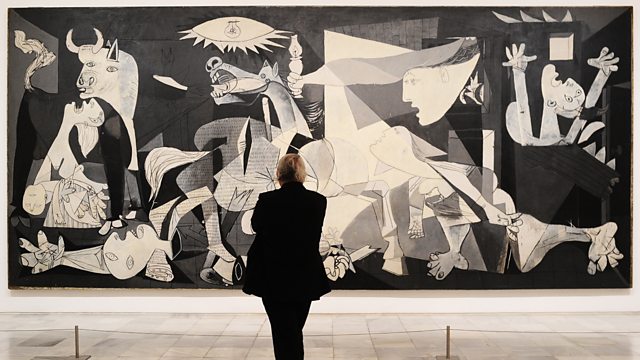Pablo Picasso’s ‘Guernica’ stands as one of the most potent anti-war statements in the history of art. A stark portrayal of the horrors of conflict, this monumental painting is a testament to the profound impact of the Spanish Civil War on Picasso and the global conscience. Delving into ‘Guernica’ means navigating the tumultuous waters of history, politics, and personal anguish. Let’s explore the tapestry of events that led to the creation of this masterpiece and its enduring significance.
1. The Horrors of Guernica
The catalyst for Picasso’s painting was a real-world tragedy:
- Aerial Bombardment: On April 26, 1937, the town of Guernica in the Basque region of Spain was subjected to a relentless aerial bombing by Nazi German and Italian Fascist airforces, supporting Francisco Franco’s Nationalist forces.
- Civilian Catastrophe: The attack, targeting a civilian population, resulted in significant casualties, with the town left in ruins. The bombardment’s brutality shook the world, illustrating the devastating capabilities of modern warfare.
2. Picasso’s Response
Deeply affected by the news of the attack, Picasso channeled his emotions onto the canvas:
- Immediate Reaction: Picasso, already commissioned to create a mural for the Spanish Pavilion of the 1937 International Exposition in Paris, shifted his focus to depict the Guernica tragedy.
- Monochromatic Palette: Using a grayscale palette, Picasso evoked the starkness of newsprint, highlighting the immediacy and rawness of the event.
3. Symbols of Despair and Chaos
‘Guernica’ is replete with harrowing images that convey the horrors of war:
- Distorted Figures: The painting showcases distorted, anguished figures—both human and animal. A grieving mother clutching her dead child, a dismembered warrior, and a bull and horse in distress—all encapsulate the chaos and suffering of war.
- Flaming Buildings: The backdrop of flaming buildings and broken structures drives home the devastation wreaked on Guernica.
4. The Legacy of ‘Guernica’
Beyond its initial impact, ‘Guernica’ has left an indelible mark on art and society:
- Universal Anti-War Symbol: The painting transcends its specific historical context, serving as a universal condemnation of war and violence. Its stark imagery has made it a rallying point for peace movements worldwide.
- Journey of the Artwork: ‘Guernica’ traveled extensively, from the International Exposition to various museums worldwide. Picasso stipulated that the painting should return to Spain only after democracy was restored, a wish fulfilled in 1981.
5. Contemporary Relevance
Decades after its creation, ‘Guernica’ remains profoundly relevant:
- Testament to Art’s Power: The painting exemplifies art’s ability to respond to, reflect upon, and challenge societal events, making it a beacon for artists addressing contemporary issues.
- Enduring Symbol: As conflicts continue to affect global landscapes, ‘Guernica’ serves as a poignant reminder of the human cost of war, urging us towards peace and understanding.
In Conclusion
Pablo Picasso’s ‘Guernica’ is not merely an artwork; it’s a cry from the depths of human despair, a plea for peace, and a reflection on the atrocities of war. By immortalizing the tragedy of Guernica, Picasso gifted the world a powerful tool to resist violence and advocate for peace. In its haunting strokes, ‘Guernica’ underscores the dire consequences of conflict and the paramount importance of unity and harmony in the face of adversity.
